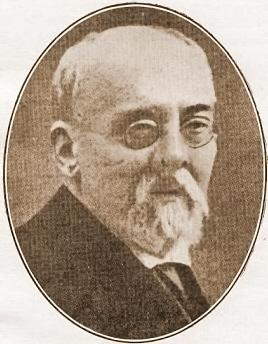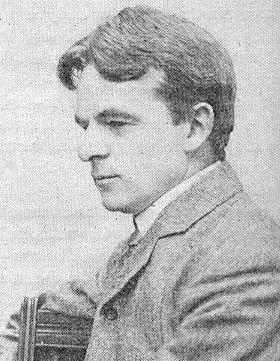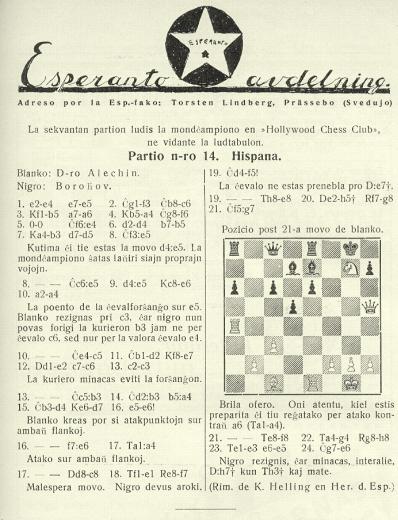
Edward Winter
An international language which possesses a relatively simple grammatical structure yet which has so often proved beyond the command of chess wordsmiths, and not least Anglo-Saxon ones. That may be regarded as a description of English, but here we offer some jottings on Esperanto, the language invented by L.L. Zamenhof in 1887.
An article entitled ‘International chess by means of Esperanto’ was published on pages 12-13 of the January 1904 BCM:
‘The appearance of a couple of articles in Lingvo Internacia, the central and oldest of the Esperanto Gazettes, on the subject of Esperanto for chessplayers, affords a fitting opportunity for briefly summarizing the advantages of [the] new international language, which in the opinion of many has “come to stay”.
The aim of Esperanto is to supply a means of international communication which can be acquired with the utmost facility. One can be much sooner efficient in Esperanto than in chess. Its simplicity results from an extremely simple grammar, consisting of only 16 exceptionless rules; its word-material is selected from those roots which are most common to the best-known European languages, causing the language to be to a large extent already known, and reducing the task of memorizing new words to a minimum, and from the employment of a consistently phonetic pronunciation …
For correspondence chess, problem tourneys, continental chess tours, or for participation in foreign tournaments, Esperanto is very useful. The articles in Lingvo Internacia translate into Esperanto some 200 chess terms, explaining them in Esperanto by means of examples. The names of the pieces in the new language are: reĝo (K), damo (Q), kuriero (B), ĉevalo (Kt), soldato (P) – names which appeal to thousands of Europeans. [The BCM article omitted the Esperanto for rook: turo.] The word “check” is ŝak (pronounced “shahk”); ŝako, a check; ŝaki, to check; ŝakado, perpetual check, etc. The chess vocabulary of Esperanto contains some very picturesque words. The original sense of the word “mate” has been reverted to, and is translated by mort [sic] (dead), thus renewing the time-honoured phrase “The king is dead”; castling becomes “the king’s leap” (reĝsalto); and stalemate is rendered by neirebleco [sic], meaning “inability to move”. The system of notation is the English, altered only so far as necessary. The commencing moves of a King’s Bishop’s Gambit might be 1 S-R4 S-R4 2 S-RK4 S kaptas (or x) S3 K-K4 S-D4 4 KxS D-T5 (ŝ) 5 R-K1, etc. Problemists are not forgotten and the principal specialities of their vocabulary are dealt with. The articles conclude with the Esperanto version of a celebrated game between Labourdonnais and McDonnell, and a couple of problems. The latter, on account of typographical difficulties, appear in the Forsyth notation, which is recommended and explained. As a result of these articles, correspondence games are now in progress between players of different nationalities.
A previous knowledge of Esperanto is not essential on the part of the receiver of a communication. If you want to write, for instance, to a Dane, you buy a 6d. Danish Instruction Book and enclose it with your letter, and the simplicity of the language is such that this is sufficient to enable him to read ordinary correspondence. There are Esperanto Instruction Books in 22 languages …’
A French translation of the article was given on page 109 of the January 1904 Revue d’échecs. Unable to reproduce the circumflex accents on consonants in Esperanto words, the BCM had improvised an alternative system; the Belgian magazine misunderstood it, thereby misspelling all Esperanto words which had accents. Whether this confusion should be regarded as an argument for or against Esperanto is open to debate.
The BCM returned to the artificial language a couple of years later (October 1906 issue, page 391):
‘Chess and Esperanto. Just before the close of the Esperanto Congress at Geneva, in September, the chessplayers took the opportunity of holding a separate meeting. The nations represented were Great Britain, France, Germany and Switzerland. An Esperantist Chess Club was formed, with Espero Katolika, one of the Esperantist magazines, as its official organ; M. l’Abbé Peltier (Tours) being elected president and Mr John Ellis (Keighley) secretary. The Congressists snatched a little time to play over the board, and pairings were made for international correspondence play. It is hoped that at the next Congress, which will take place in England (and perhaps at Cambridge), a match between the Esperantists and a local team may be arranged.’
Page 104 of the March 1910 La Stratégie quoted a report from the Journal de Rouen that the international association created some years previously had enjoyed only a short life, the main reason being that the group did not have a specialized journal. However, the idea had been taken up again at the Esperanto Congress in Barcelona in 1909, with plans for translations of chess literature into the new language.
Indeed, in 1909 a book of problems in Esperanto was published in Barcelona by J. Paluzíe y Lucena: Sesdek Ŝakproblemoj. It was reviewed by Philip H. Williams on page 344 of the Chess Amateur, August 1909:
‘… The novelty of the publication lies in the fact that it is in Esperanto – there is a large amount of letter-press amongst the solutions, and some of this language I appear to be able to read quite easily, in a hazy way, although I have never studied it. The fly-leaf which accompanies it contains perfectly intelligible sentences although I could not specifically translate any word. The idea is a good one, though I must say that a collection of problems is almost in a universal language in itself, since the diagrams and solutions are the same, practically, in most European languages. In Esperanto the bishop is referred to with the letter K – a confusing item to English readers. There is a sort of essay at the end, in Esperanto, German, French and English, in which the manifest advantages of Esperanto are urged. The author suggests that all writers on chess should adopt it …
Señor Paluzíe deserves the credit of having produced the first chess work in Esperanto, and it is to be hoped that his example will be quickly followed by others.’

José Paluzíe y Lucena
Other references to Esperanto appeared in the Chess Amateur of September 1909 (page 374), October 1909 (page 25), June 1910 (page 288) and August 1910 (page 352). The last of these concluded with the editorial comment:
‘Although fully in sympathy with the efforts for the extension of Esperanto, we fear a column in the Chess Amateur would at present find little favour. A time may come when a chess magazine wholly in Esperanto will find readers in many countries.’
As noted in various periodicals (e.g. on page 156 of the July 1913 American Chess Bulletin), that year saw the publication of a 90-page brochure by Paluzíe on the problems of Valentín Marín, Un artista en ajedrez with a translation into Esperanto by Federico Pujulà y Vallès.
Philip Williams reverted to the subject of Esperanto in the Chess Amateur of May 1920, pages 229-230:
‘A scheme for the publication of a universal chess magazine is suggested. It is one which I would warmly support, though I know nothing of that “invented” language. … For myself, I have the average smattering of French, and a nodding acquaintance with German, Italian and Latin. As an average, therefore, I find I can understand Esperanto in bits with no tuition whatever …
I have more than once seen critiques of my problems on some Polish newspaper, which, of course, convey nothing to me; but it looks like what a man would say in a dispute with a taxi-man, but with somebody else’s false teeth in his mouth. The projected publication would obviate these phenomena.’
He also discussed general translation problems (July 1920 issue, page 295):
‘What did the French furniture dealer understand by the British buyer who said to him:
“Avez-vous une poitrine de caleçon? Non? Jamais esprit. Je ferai sans.”
Translate: “Have you a chest-of-drawers? No? Never mind, I will do without.”
Esperanto, if only taken up extensively and internationally, would prevent these absurdities.’

Philip Hamilton Williams
On page 328 of the August 1920 Chess Amateur Williams stepped up his advocacy of the language:
‘When one has to find out what is meant, internationally, by looking up a specific word in the dictionary, it seems high time that Esperanto should be exploited. How can statesmen hope to thrash out delicate international matters through the media of interpreters?’
A final passage by Williams comes from the July 1921 Chess Amateur (page 299):
‘Talking of the difficulties of language in chess, there seems to be no development of the idea of a magazine in Esperanto. I remember attending some political meetings in London, when all the candidates were asked if they approved of the idea of Esperanto as a means of facilitating diplomacy internationally. All of course said they did – one candidate not knowing what it meant (this by his manner of answering). However, it was of no consequence, as the one who got in, like several hundreds of others, never opens his mouth from one month’s end to the other on any topic whatsoever, whether he “approves” or not. He merely goes to vote as he is told. He has no more chance of following up his promises about Esperanto or any other matter than the man in the moon.’
After Williams’ death the following year, Esperanto was seldom mentioned in, at least, English-language chess literature, although we note that on page 5 of the January 1932 BCM Ronald C. Macdonald wrote:
‘Abroad one can become quite friendly through chess – with people who cannot exchange a word with you – a universal Esperanto.’
A regular column in Esperanto appeared in the Swedish magazine Schackvärlden starting with the January 1935 issue, and a sample extract (page 165 of the March 1935 issue) is given below:

It is naturally impossible to list exhaustively the various chess books and articles which have, over the years, tried to advance the cause of Esperanto in chess. Whether any groups or associations with that objective exist today, we do not know.
(2938)
From page 87 of CHESS, 13 December 1958:
‘I am seeking British chess players who would be prepared to join the International Association of Esperanto Chess Players.
I am making this request on behalf of the Secretary of the Association, Mr J. Duthilleul of Caen in France – K. McLennan B.Sc. (8 College Road, Exeter).’
An item from page 237 of the August 1957 Chess Review:

Page 58 of Womanhood, 1904 had a list of subscribers to a purse for James Mason and included, inaccurately, ‘John Ellis (inventor of Esperanto)’.
Page 61 of the Schweizerische Schachzeitung, April 1921 has an article entitled ‘Le Jeu d’Echecs et l’Esperanto’ by R. Richez of Geneva.
On pages 12-15 of the Chess Player’s Annual and Club Directory, 1890 by Mr and Mrs T.B. Rowland there is a recommendation that chess players should adopt Volapük.
To the Chess Notes main page.
To the Archives for other feature articles.
Copyright: Edward Winter. All rights reserved.